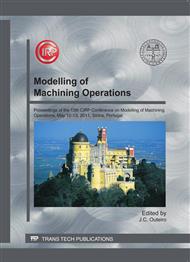p.464
p.473
p.483
p.495
p.505
p.514
p.525
p.535
p.545
Identification of Surface Generation Mechanisms Based on Process Feed-Back and Decomposition of Feed Marks
Abstract:
This paper proposes a novel integrated approach to the prediction of surface generation mechanisms which takes into account both cutting process outputs and distortions of the individual feed marks in comparison to an ideal kinematical model. For this task, the recorded surface roughness profile was decomposed using special algorithms. The mechanisms of real surface generation considered include the plastic side flow and spring back effects, the cutting edge sharpness and its wear, and dynamic interactions between the tool and the workpiece. The computation procedure was verified for different workpiece materials in conjunction with uncoated and coated, sharp and worn, tools.
Info:
Periodical:
Pages:
505-513
Citation:
Online since:
April 2011
Authors:
Price:
Сopyright:
© 2011 Trans Tech Publications Ltd. All Rights Reserved
Share:
Citation:


